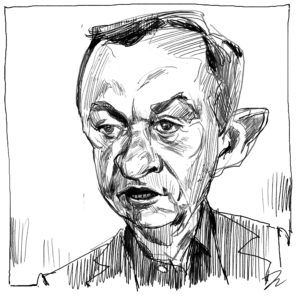Could anybody bend it like Beckham?
Maybe – if they practised for about 10,000 hours. An Olympic sportsman turned award-winning sports writer argues that the idea of natural talent is overrated.

Want to read spiked ad-free? Become a spiked supporter.
How did Matthew Syed, a boy from an ordinary suburb in south-east England with no sporting background, come to be England’s top table tennis player and a double Olympian? At the time he believed it was ‘a triumph of individuality’ solely based on his personal attributes and skills. Later, as he moved from being a sportsman to an award-winning sports writer with The Times (London), Syed started to question this ‘romantic’ version of his rise.
Could it be a coincidence, for example, that the unexceptional road where he had grown up was also home to several other top young ping-pong players? ‘For a period in the 1980s, this one street and the surrounding vicinity produced more outstanding table tennis players than the rest of the nation combined.’ Now he sees that that had to be down to a coincidence of other factors, primarily the role of a teacher at his local school who happened to be England’s top table tennis coach, and recruited Syed, his older brother and other promising youngsters to a local club, uniquely with 24-hour access. The Syed brothers also had each other to practice against for hours a day, and had begun with a tournament-sized table in their parents’ large garage. The rest, as they say, is history.
Syed’s coldly honest appraisal of his own success – he says that if enough other youngsters had shared his opportunities he would not have been number one and might not even have been ‘number one thousand and one in England’, which seems rather harsh – marks the starting point of Bounce. From there Syed sets out to demonstrate that sporting champions such as him, and the true greats of sport, are made, not born.
Here at spiked we have a penchant for myth-busting, and Syed takes apart more than his share of mythical mainstream assumptions, from ‘the talent myth’ to the ‘myth of meritocracy’ and the ‘myth of the child prodigy’. Drawing on the work of academics and researchers, and lining up an impressive field of statistics alongside colourful anecdotes, his central point concerns ‘the primacy of practice’. However talented we might think they are, nobody achieves excellence in sport – or indeed any other field of complex endeavour – without putting in the effort for at least 10 years, which is generally thought to translate into 10,000 hours of practice. And not just any old practice, but ‘purposeful practice’, drawing on the best available techniques and possibly coaching. The moment of sporting perfection we might witness as spectators and ascribe to the athlete’s genius is simply what Anders Ericsson, a psychologist whom Syed champions, calls ‘the iceberg illusion’, beneath which lie the long unseen years of hard purposeful practice.
Syed deploys top-class case studies to question the myths of natural talent. Mozart was perhaps the most famous child prodigy, but it is often forgotten how he was schooled by his father, a composer and performer in his own right. Wolfgang Amadeus might have composed his first great work at the startlingly tender age of 21, but by that time he had already completed 18 years of hard training. From modern sporting talents such as David Beckham to Tiger Woods or Andre Agassi – whose father taught him that a kid who hit 2,500 balls a day and thus a million balls a year would be ‘unbeatable’ – the same pattern of long years of purposeful practice holds true.
Why do the top sportsmen and women always seem to have, in the commentator’s cliché, ‘more time’ to do the business than us mere mortals? Syed suggests that the secret of this ‘time paradox’ lies not in their genes but in their long hours of experience. A tennis champion such as Roger Federer was not born with quicker reactions than the rest – indeed they can often be slower than many in non-tennis situations – but has learned to predict where his opponent’s serve will arrive almost without thinking, through the ‘exploitation of advanced information’ programmed into him by purposeful practice.
And perhaps the same cold logic can be applied to sporting myths about entire populations. Why, for example, have so many Brazilians seemed to exhibit brilliant footballing skills? The common European feelgood story about how they all grow up having fun playing beach soccer hardly seems to explain why so many great players grew up playing in the cities and slums where there are no beaches. Syed suggests it might have rather more to do with the endless games of ‘futebol de salao’ or ‘futsal’ young Brazilians play, a game played with a smaller, heavier ball in tight spaces that puts a premium on developing sharper skills and a better touch, and removes the option of hoofing it up the pitch.
Syed also cites research that suggests an individual’s attitude to where talent comes from can determine how well they do in sport or school. Those who demonstrate the ‘fixed mindset’, by believing that you are what you are born, are less likely to rise to an occasion and improve their skills than those who exhibit the ‘growth mindset’ and believe people can get better if they try harder.
Bounce makes the sizeable leap from this analysis to conclude, along with the experts Syed favours, that the possibility of achieving excellence can be open to almost anybody. Some may well balk at the idea that any of us could really bend it like Beckham. But what seems certain is that you will never know how good you can be unless you try, try again for about 10,000 hours, and that even young Beckham could never have learnt to bend it like himself without an unglamorous youth spent almost entirely on the playing fields of north-east London and then the Manchester United training ground. I seem to recall the South African golfer Gary Player responding to the suggestion that he was a ‘lucky’ player by saying: ‘Yes, and the funny thing is, the harder I practice, the luckier I get.’
Syed allows, by the way, that the same rules do not apply directly to less ‘complex’ sports, such as running. None of us could compete with the awesome Usain Bolt over 100 metres, no matter how hard we trained (though we could all get a lot faster trying). But here, too, Syed rehearses some interesting arguments about the simplistic myths of racial stereotyping around the supremacy of black sprinters and distance runners.
In another century I used to run an ‘Introduction to Marxism’ course at a political summer school, one session of which was devoted to questioning attendees’ assumptions about human nature, and demonstrating that there is an important social or human-made factor in almost everything ‘natural’. This was about establishing, as Marx famously had it, that man makes his own history, though not in circumstances of his own choosing. (And it had nothing in common with the current miserabilist fashion for blaming everything from floods to flu or bad food on ‘manmade’ interference with nature.)
So on the basis of my own years of experience challenging the natural determinist explanation of humanity’s endeavours, my (non-natural) inclination is certainly to side with Syed as he delivers well-deserved thrashings to many of the lazy prejudices of the punditocracy and concludes that innate ‘talent is overrated’, not only in sport but in wider society. I always remember the story of how the young Georgie Best, the most ‘naturally talented’ footballer I ever saw, was once told by his coach that his left foot was too weak. The schoolboy Best’s response was to wear a plimsoll on his favoured right foot and train, play and score only with his left to sort out that ‘natural’ problem.
Syed’s line of attack becomes more questionable only when he seems to stray a little too far down the line of what is sometimes called evolutionary psychology, and suggests that certain behaviours and responses can be hardwired into our DNA or minds. In discussing why so many sportsmen indulge in superstitious rituals, for example, it is hard to take seriously a statement such as, ‘The fact that pigeons and humans share superstitious tendencies suggests that this kind of behaviour emerged quite early in evolutionary history’.
More interesting here is Syed’s discussion of the sporting curse known as ‘choking’, the blowing of a lead or an opportunity to succeed through an apparent loss of nerve, embodied in popular memory by the likes of Australian golfer Greg Norman or several England penalty-fluffers such as Gareth Southgate. This is a subject unfortunately close to Syed’s heart, as he painfully explains how he was ‘humiliated’ at the 2000 Olympic Games in Sydney when he somehow saved his worst-ever performance for his most important tournament. Syed summons his team of psycho-experts to argue that the explanation for such aberrations lies in the ‘tale of two brain systems’, the explicit and the implicit, which supposedly develop spontaneously as a sportsman progresses. He thus concludes of choking that, thanks to the two brain systems, ‘it just happens’ and there is nothing to be done. But there is surely a danger of that explanation sounding almost as biologically determinist as those that would mythologise the sportsman’s natural traits.
It would be a shame to let such issues overshadow the central theme of Bounce, which brilliantly illustrates the capacity of humans, in sport and real life, to rise above their circumstances and ‘natural’ limitations and meet the most daunting of challenges. Sporting success is clearly not, as some of the psycho-babblers might tend to imply, all in the mind. In the end, as we used to conclude our ‘Introduction to Marxism’ discussion, it may well be impossible to be certain exactly how much of an individual’s attributes are inherited or acquired until we live in a world where all of the other social impediments and inequalities have been removed (and there is still little immediate prospect of that).
In the meantime, Syed’s book provides an often-uplifting story of how champions are made, not born. It is symbolised by the tale of the great Olympic skating gold medallist Shizuka Arakawa of Japan, who is estimated to have endured some 20,000 falls on the ice in the course of her young lifetime’s training to leap and spin like a champion. As one sports writer had it, ‘Landing on your butt 20,000 times is where great performance comes from’. She made history, even if it was definitely not in circumstances of her own choosing.
Mick Hume is editor-at-large of spiked
Bounce: How Champions are Made, by Matthew Syed, is published by Fourth Estate. (Buy this book from Amazon(UK).)
Who funds spiked? You do
We are funded by you. And in this era of cancel culture and advertiser boycotts, we rely on your donations more than ever. Seventy per cent of our revenue comes from our readers’ donations – the vast majority giving just £5 per month. If you make a regular donation – of £5 a month or £50 a year – you can become a and enjoy:
–Ad-free reading
–Exclusive events
–Access to our comments section
It’s the best way to keep spiked going – and growing. Thank you!










Comments
Want to join the conversation?
Only spiked supporters and patrons, who donate regularly to us, can comment on our articles.